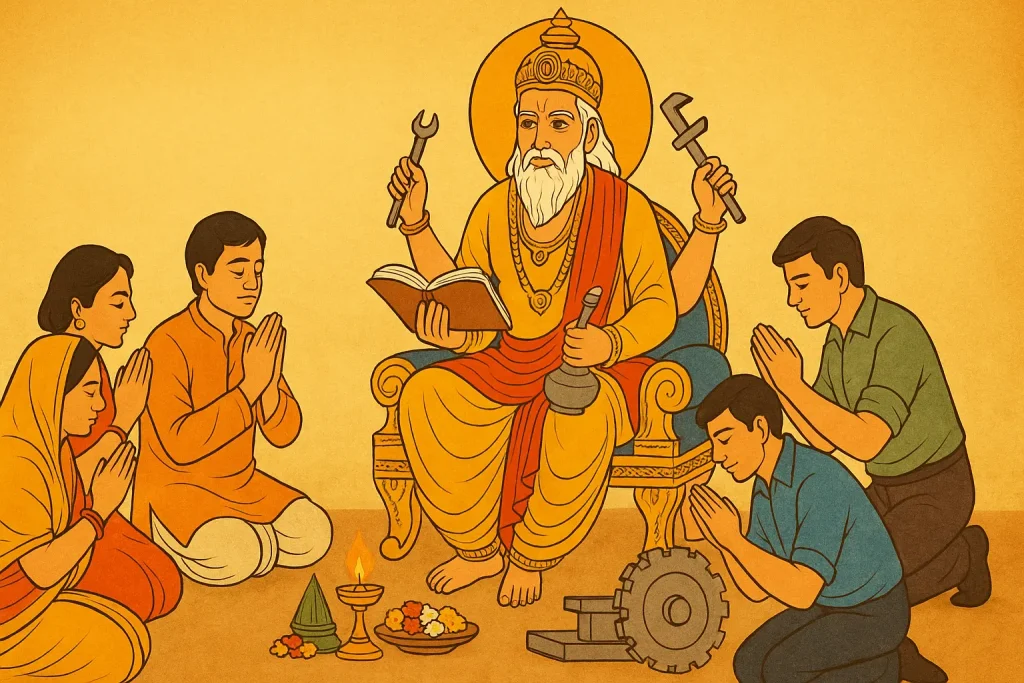
Have you ever thought—behind every festival, every ritual, and every fast, there is not just a tradition, but a deep hidden story?
If you too want to discover the hidden mysteries of every tale and the timeless messages of every festival, this story is for you.
Every year on 17/18 Sep, we celebrate Vishwakarma Puja. Today, we will explain the story of Lord Vishwakarma
The Birth of Lord Vishwakarma
When the universe was newly formed, Brahma realized that creation alone was not enough. To expand and beautify the cosmos, there had to be someone who could shape it with design, order, and craftsmanship.
So from his divine radiance, Brahma created a celestial being. His eyes glowed with light, his hands held the tools of art, and his very presence carried the essence of creation.
This was Lord Vishwakarma—the divine architect of the gods.
The Rigveda calls him none other than the form of Supreme Brahman. It says:
He is the one who shaped the Sun and Earth, who gave form to the sky and directions.
Different scriptures give different versions of his origin:
- Some say he is Brahma’s mind-born son.
- Others call him the son of Prajapati Tvashta and Bhavna Devi.
- The Bhavishya Purana says he was born from Goddess Bhuvaneshwari.
But all agree on one truth: without Vishwakarma, neither the heavens could be built nor human civilization could flourish.
Vishwakarma’s Role in Creation
According to Puranic stories, Brahma entrusted Vishwakarma with shaping the universe.
Initially, creation emerged like a cosmic egg. Brahma placed it upon Sheshnaag, but every movement of the serpent shook it.
Troubled, Brahma sought Vishwakarma’s help. Vishwakarma then placed Mount Meru into the waters to stabilize creation.
This act displayed his genius, and from then on, he was honored as the world’s first engineer and architect.
Marvels of Vishwakarma’s Architecture
Vishwakarma’s creations are legendary:
- In Satyuga – he built Swarga (Heaven)
- In Treta Yuga – the Golden Lanka
- In Dwapar Yuga – the city of Dwarka
- In Kaliyuga – Hastinapur and Indraprastha
Other great works include:
- Indrapuri for Indra
- Yampuri for Yamaraj
- Varunapuri for Varun
- Kuberpuri for Kuber
He also created divine weapons:
- Lord Shiva’s Trishul
- Lord Vishnu’s Sudarshan Chakra
- Lord Indra’s Vajra
Without these, the gods’ victory over evil would have been impossible.
He even crafted the Pushpak Vimana, the flying chariot of gods and demons.
From cities to palaces, from machines to weapons, Vishwakarma’s hand shaped it all.
Forms and Lineage
The scriptures describe five forms (avatars) of Vishwakarma:
- Virat Vishwakarma
- Dharmavanshi Vishwakarma
- Angiravanshi Vishwakarma
- Sudhanva Vishwakarma
- Bhrigu-vanshi Vishwakarma
He is often shown in many forms—sometimes with two arms, four arms, or ten arms, and faces ranging from one to five.
His eldest son was Rishi Manu, who married Kanchana, daughter of Sage Angira.
Depiction of Lord Vishwakarma
Traditionally, Lord Vishwakarma is shown seated on a throne, adorned with yellow garments and jewels:
- One hand holds the Vishwakarma Purana
- Another holds a book
- The third carries tools, symbolizing construction
- The fourth a kamandalu, symbol of creation
Why Vishwakarma Puja is Celebrated
Every year, during Kanya Sankranti (around September 17–18), when the Sun begins its southward journey, we celebrate Vishwakarma Puja.
On this day, artisans, laborers, engineers, farmers, and factory workers worship not only Lord Vishwakarma, but also their tools and machines.
From a carpenter’s saw, blacksmith’s hammer, farmer’s plough, to an engineer’s computer—every instrument is decorated and revered as divine.
The rituals include:
- Bathing and cleaning homes/workplaces
- Installing Vishwakarma’s idol or image
- Purifying with Ganga water
- Lighting lamps, offering flowers, rice, and sweets
- Chanting “Vishwakarmane Namah”
- Performing Aarti and distributing Prasad
The most important part is the vow—to work in the coming year with honesty, devotion, and dedication.
The Deeper Message
Vishwakarma Puja teaches us that labor itself is worship.
- If a farmer doesn’t plough, there is no food.
- If a carpenter doesn’t shape wood, houses cannot be built.
- If an engineer doesn’t design machines or bridges, society cannot progress.
Every work—small or big—is essential for the balance of creation.
And when done with sincerity, it becomes an offering to God.
That’s why a worker’s sweat is said to be the purest holy water, and his tools the truest objects of worship.
Even in today’s age of technology, this festival reminds us:
Machines and science succeed only when joined with labor and dedication.
It inspires us to respect our tools, honor our work, and contribute not just to our own lives but to society and the nation.
Because when humans work with love and integrity, they themselves become reflections of the divine.
Conclusion
So friends, Vishwakarma Puja is not just the worship of a deity—it is the worship of every hand that works, every tool that creates, and every mind that finds joy in labor.
Its timeless message is clear:
👉 Labor is the greatest religion, and creation is the highest meditation.





